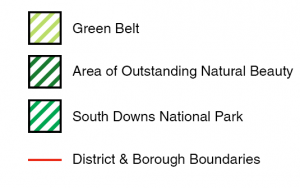The key facts
The reality is that Horsham District Council are currently required to build 800 new houses per year. The council have now published that this number will significantly increase for the next plan period (2019 – 2036), estimated to be between 1,200 and 1,400 new houses per year.
This is based on housing delivery numbers from Central Government and the requirement for Horsham to take housing numbers from Crawley, Brighton and Worthing as they cannot provide all of the major new housing needed in their areas.


Areas for development in the region are already restricted due to the South Downs National Park covering the south, the Green Belt above and the High Weald Area of Outstanding Natural Beauty (AONB) in the east.
Horsham needs to build between 21,600 and 25,200 new houses in the plan period, which can be delivered by a number of strategies. Three of the most likely strategies are outlined below:
What is Option 1?
Developments around existing towns and villages
Option 1 would focus new development within and adjacent to the existing settlements in the district.
It is normal with these smaller, more piecemeal developments that contributions towards the required infrastructure is collected from each individual development.
Hopefully somewhere down the line the fund is used to deliver the required infrastructure. It is however not uncommon, due to changes in the economic climate and other adverse pressures, that this infrastructure is never actually delivered, for example the primary school at Broadbridge Heath.
Without properly planned, infrastructure-led developments you can see the potential impact this strategy could have on your local town or village below, with indicative locations.
What are the consequences of delivering Option 1?
- The normal consequences on local towns and villages is that if and when the infrastructure is delivered, it is usually at the end of a development and years can elapse without the infrastructure in place
- A real chance that the required infrastructure will never be delivered due to higher land values on smaller developments and less available funds for infrastructure delivery such as traffic improvements, healthcare and education
- An increased chance of having to extend existing schools and surgeries where the potential constraints do not allow everything that was required to be delivered, such as not enough space available
- Using a proportional amount of development relevant to the existing size of town or village, we have nominally allocated 4,000 houses developed in Horsham and almost 2,000 houses both in Billingshurst and Southwater
- Then approximately 1,000 houses developed in other towns / large villages and 500 units developed in medium to small sized villages
Main town:
Small towns:
Large villages:
Small / medium villages:
Potential impact on towns and villages
The impact of focusing new development around existing settlements include:
- New houses without the supporting infrastructure, resulting in:
– Higher demand for spaces at existing schools
– Even higher pressure on existing GP surgeries
– Increased traffic in villages and towns and reduced parking places - No new commercial/employment space to provide jobs for new residents, resulting in increased pressure on commuter network
- No provision of new public open space despite increased demand
What is Option 2?
Planned new places with all supporting infrastructure
Large, strategic sites should have the space and opportunity to provide the major infrastructure to enhance the existing local services and benefit the wider community.
What are the benefits of delivering Option 2?
The council needs to ensure that it picks the right sites in the right locations that can deliver all of these benefits, and ask if these sites will:
- Be designed around the green agenda
- Be built with a sustainable future in mind
- Improve community facilities and services
- Deliver major infrastructure, such as new schools and healthcare
- Deliver transport infrastructure, such as highways and junction improvements
- Deliver green infrastructure such as new public parks and paths through countryside
- Be policy compliant with affordable housing
- Provide increased commercial/employment space so more people can work locally
What is Option 3?
A combination of options 1 and 2
A mixture of developments in existing towns and villages with large, strategic sites to meet the housing need in the district.
